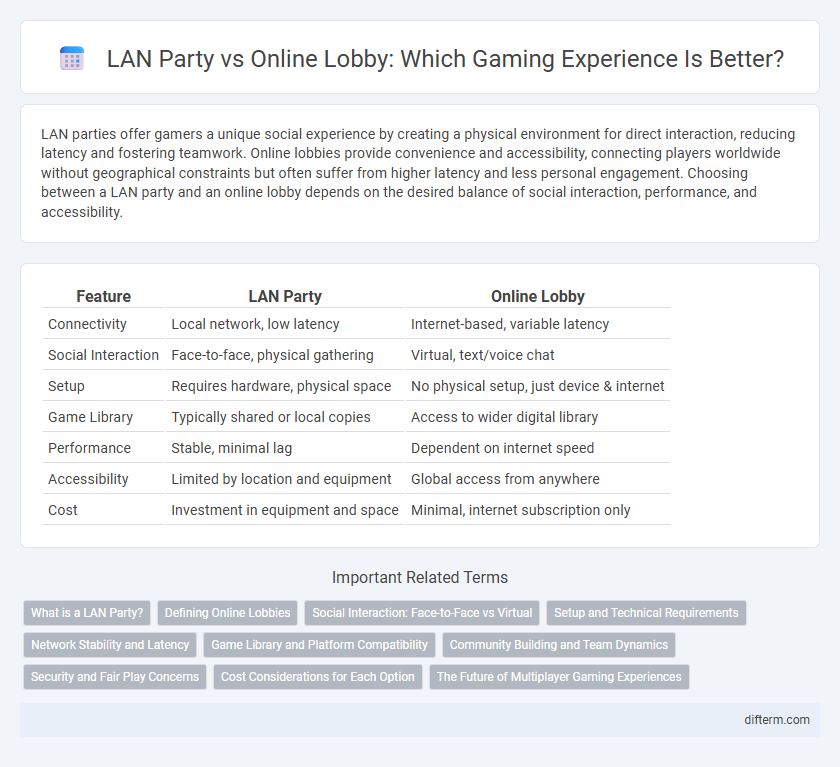LAN parties offer gamers a unique social experience by creating a physical environment for direct interaction, reducing latency and fostering teamwork. Online lobbies provide convenience and accessibility, connecting players worldwide without geographical constraints but often suffer from higher latency and less personal engagement. Choosing between a LAN party and an online lobby depends on the desired balance of social interaction, performance, and accessibility.
Table of Comparison
| Feature | LAN Party | Online Lobby |
|---|---|---|
| Connectivity | Local network, low latency | Internet-based, variable latency |
| Social Interaction | Face-to-face, physical gathering | Virtual, text/voice chat |
| Setup | Requires hardware, physical space | No physical setup, just device & internet |
| Game Library | Typically shared or local copies | Access to wider digital library |
| Performance | Stable, minimal lag | Dependent on internet speed |
| Accessibility | Limited by location and equipment | Global access from anywhere |
| Cost | Investment in equipment and space | Minimal, internet subscription only |
What is a LAN Party?
A LAN party is a gathering where gamers connect their computers or consoles to a Local Area Network (LAN) to play multiplayer video games together in the same physical space. This setup offers low latency, high-speed connections, and a social atmosphere, enhancing competitive and cooperative gameplay experiences. LAN parties are preferred for games requiring fast response times, such as first-person shooters and real-time strategy games, due to minimal network lag compared to online lobbies.
Defining Online Lobbies
Online lobbies serve as virtual gathering spaces where gamers connect remotely to join multiplayer matches, offering a seamless and accessible alternative to traditional LAN parties. These platforms support matchmaking, chat functions, and real-time updates, enabling diverse players to compete or collaborate without geographic constraints. Online lobbies enhance gaming experiences by providing instant access to global communities, fostering dynamic interactions beyond physical locations.
Social Interaction: Face-to-Face vs Virtual
LAN parties foster direct social interaction with players physically present, enhancing communication through body language and immediate feedback. Online lobbies enable connection across distances, relying on voice or text chat that can lack the depth of face-to-face engagement. Physical proximity in LAN settings often leads to stronger camaraderie and spontaneous social dynamics compared to virtual environments.
Setup and Technical Requirements
LAN parties require a local area network setup with high-speed Ethernet connections to minimize latency and ensure stable gameplay, often demanding physical space, routers, and switch configurations. Online lobbies rely on robust internet connections, server stability, and platform-specific software, eliminating the need for shared hardware but necessitating higher bandwidth and firewall optimization. Both setups demand compatible gaming hardware and updated software, but LAN parties prioritize network infrastructure while online lobbies emphasize internet quality and server performance.
Network Stability and Latency
LAN parties offer superior network stability and significantly lower latency due to direct, local connections that eliminate internet-related disruptions and packet loss. Online lobbies depend on internet service providers and global routing paths, which can introduce variable latency and increased jitter, impacting real-time gameplay responsiveness. Dedicated LAN setups ensure consistent bandwidth allocation, minimizing lag and providing a smoother competitive gaming experience compared to the unpredictable nature of online lobby connections.
Game Library and Platform Compatibility
LAN parties offer seamless local multiplayer experiences with a diverse game library optimized for direct device connections, minimizing latency and enhancing real-time interaction. Online lobbies provide broader platform compatibility, supporting cross-play across consoles, PCs, and mobile devices, expanding access to multiplayer games regardless of hardware differences. Choosing between LAN parties and online lobbies depends on the preference for low-latency, local network gaming versus the convenience of platform-agnostic multiplayer access.
Community Building and Team Dynamics
LAN parties foster stronger community building and team dynamics by enabling face-to-face interactions and real-time communication among players, enhancing trust and collaboration. Online lobbies offer convenience and accessibility but often lack the personal connection and immediate feedback that boost teamwork and camaraderie in physical settings. The immersive environment of LAN parties cultivates deeper social bonds and coordinated strategies, making them ideal for cohesive team play.
Security and Fair Play Concerns
LAN parties offer enhanced security by limiting gameplay to a trusted local network, significantly reducing risks of hacking and cheating compared to online lobbies, which are more vulnerable to external cyber threats and account compromises. Fair play is more easily enforced in LAN settings through direct oversight and the absence of network latency, creating a more level competitive environment than online lobbies, where variable internet speeds and potential exploit usage can undermine game integrity. Consequently, LAN parties provide a controlled environment that prioritizes secure connections and equitable competition for gamers focused on fair play.
Cost Considerations for Each Option
LAN parties typically incur upfront costs such as purchasing or renting networking hardware, physical space, and electricity, but offer near-zero latency and a one-time expense for participation. Online lobbies eliminate the need for physical setup and associated utilities, relying instead on internet bandwidth and potential subscription fees for premium services or platforms. For gamers prioritizing budget, LAN parties may be more cost-effective for local groups, whereas online lobbies provide scalable access with variable ongoing costs depending on connectivity and platform features.
The Future of Multiplayer Gaming Experiences
LAN parties offer low-latency, immersive social interactions that create a unique communal gaming atmosphere difficult to replicate in online lobbies. Online lobbies provide extensive scalability, ease of access, and continuous updates enhancing global connectivity and player matchmaking efficiency. Future multiplayer gaming experiences will integrate the physical engagement of LAN parties with the dynamic, borderless environment of online lobbies through hybrid platforms leveraging 5G connectivity and cloud gaming technology.
LAN Party vs Online Lobby Infographic

 difterm.com
difterm.com